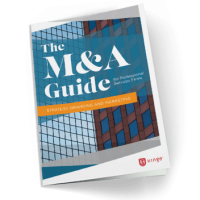An M&A Integration Checklist
Post-merger or acquisition, most leaders are focused on the quantifiable steps of the integration such as cutting costs and streamlining efficiencies. While that’s all well and good, I’m going to walk out on a limb here and suggest a slightly novel prioritization of tasks – why not put your people first in an M&A integration checklist?
At professional services firms, people are your product and, to invoke a cliché, your most valuable asset. But what does that mean?
Your firm’s singular mix of talents, personalities, skillsets, and leadership are key components of your brand and contribute to your reputation. As you integrate with a new entity, it only makes sense to preserve the best parts of the culture you have worked so hard to establish.
Here’s a merger & acquisition integration checklist that starts with your people, as it’s critical to retain their loyalty and expertise.
1. Culture.
If you are undergoing a merger or acquisition, you’re in a bubbling cauldron of change. Whether two cultures are co-mingling, or one has literally acquired the other, there are probably more similarities than meet the eye. Suppose two competing industry giants are thrown together. Chances are, their missions resemble one another, but the expectations set by management are very different.
If a merger or acquisition is to succeed, a new culture must emerge. If you look for the best elements of both cultures you can develop a workplace that is both familiar and fresh to everyone. But how do you uncover these elements?
A little internal research can go a long way. Survey your employees and identify the common themes in each group. Ask what they liked most and least about their work environments, the way they delivered services, and their firms’ management styles. Compare the responses and themes from both organizations. Then see if you can develop a culture that includes elements of both.
While it may be impractical to build a new internal culture from scratch — one organization’s established culture is likely to dominate — the merger or acquisition is much more likely to be successful if you can accommodate all parties to some extent.
2. Employer brand.
Your recruiting and retention efforts have never been more important. In a time of change and competing priorities, how do you ensure your employees feel valued and supported? Happy employees provide quality service, while disgruntled employees can be less committed to that end result.
After a merger or acquisition, usually one of leadership’s first thoughts is to cut costs. This instinct to take away is what threatens employee morale, work product, and client experience. Why not focus instead on the employee experience and retaining your best people?
Don’t rush to decisions — listen to your employees and what is important to them. And never take the small things for granted. Work-from-home Fridays or hybrid work opportunities might be the reason many people took the job and taking away that perk might be the reason they leave. If your employees feel they are at risk of losing the parts of their job that they value the most, you’ve got a tough road ahead of you.
And just as it’s important to retain people, it’s important to recruit, too. No one wants to work for a company that has a revolving door of talent. Constant turnover is not attractive to potential candidates as it is a sign of instability and turmoil. The employer brand you portray now will directly impact your ability to scale.
3. Internal Comms.
Be the liaison your firm needs you to be. Your goal should be to build a culture of transparency and rapport. How — and how clearly — you communicate now will play a direct role in the success of the integration.
Do yourself a favor and don’t skip over the introductions. It’s critical that your new family operates as one — and that a close-knit dynamic doesn’t happen overnight. The key is to make sure you are covering your bases. Nothing can be more detrimental than if one part of the firm feels favored over the other.
Storytelling can be a powerful tool. Each organization needs to learn about the other, so consider asking each side to share stories about notable client engagements and important internal events — whatever experiences will help the two parties coalesce and bond. How you share these stories will depend on the size and structure of the firm, but try to encourage individuals to tell stories in their own voice, whether spoken or written.
And make sure your communications are thoughtful and strategic. Your plan won’t work if your message is unclear and doesn’t deliver the intended impact.
4. Branding and marketing.
Unless a merged or acquired firm is taking on the identity of the dominant brand, a merger or acquisition presents a great opportunity to reposition your firm or do a brand refresh. But first, you need to understand how the two firms are perceived in the marketplace and internally amongst employees. Brand research can identify opportunities in the marketplace that will inform your new positioning. Use the occasion to strengthen your reputation and increase your visibility. A stronger brand will resonate not only with your clients but also with your own employees – moving your closer to that unified brand culture.
5. Business Development.
If you don’t shape the narrative about your firm, your clients will create their own story, one that won’t necessarily reflect who you are. Make sure your people are on the same page and are saying the same thing. Identify messages for each of your audiences and equip your business development team to answer the hard questions.
6. Processes and procedures.
It’s no accident that I’ve saved this one for last. Only after the integration is complete will you know what operations and procedures you need to support your marketing objectives and culture. While a lot of effort and expense can go into the operational systems and procedures, their impact is often overestimated. When the post-merger integration is complete you want to end up with systems and processes that support your strategy, marketing objectives, and culture. They may come from either firm.
People are the building blocks of every professional services firm, so you’ll want to make sure they are taken care of. While leadership will always remain focused on the quantifiable aspects of a merger or acquisition, you can undermine the success of an M&A growth strategy if you don’t put your people first. Without the right people — happy, highly motivated professionals — the integrated firm isn’t likely to achieve the efficiencies and synergies that the merger or acquisition promised. But if you take these six factors into account, your odds of success improve dramatically.
How Hinge Can Help
Develop rebranding strategies that better connect with existing clients and prospects. Hinge’s Branding Program can help your firm stand out from the competition and build a brand that drives sustained growth.
Additional Resources
- Get strategies, tips, and tools for developing your firm’s brand with Hinge’s Brand Building Guide for Professional Services Firms.
- Download a free copy of the book Inside the Buyer’s Brain to learn how to build a powerful brand to help your firm close more sales.
- For more hands-on help on becoming the next Visible Firm®, register for our Visible Firm® course through Hinge University.






